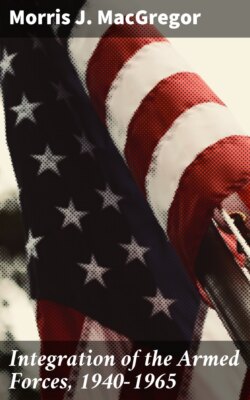Читать книгу Integration of the Armed Forces, 1940-1965 - Morris J. MacGregor - Страница 48
На сайте Литреса книга снята с продажи.
A Problem of Quotas
ОглавлениеThe War Department encountered overwhelming problems when it tried to put the Gillem Board's recommendations into practice, and in the end only parts of the new policy for the use of black manpower were ever carried out. The policy foundered for a variety of reasons: some implicit in the nature of the policy itself, others the result of manpower exigencies, and still others because of prejudices lingering in the staff, the Army, and the nation at large.
Even before the Army postwar racial policy was published in War Department Circular 124 on 27 April 1946 it met formidable opposition in the staff. Although Secretary Patterson had approved the new course of action, the Assistant Chief of Staff for Personnel, General Paul, sent a copy of what he called the "proposed" policy to the Army Air Forces for further comment.[7–1] The response of the air commander, General Carl Spaatz, revealed that he too considered the policy still open for discussion. He suggested that the Army abandon the quota in favor of admitting men on the basis of intelligence and professional ability and forbid enlistment to anyone scoring below eighty in the entry tests. He wanted the composite organizations of black and white units recommended by the board held to a minimum, and none smaller than an air group—a regimental-size unit. Black combat units should have only black service units in support. In fact, Spaatz believed that most black units should be service units, and he wanted to see Negroes employed in overhead assignments only where and when their specialties were needed. He did not want jobs created especially for them.[7–2]
These were not the only portents of difficulty for the new policy. Before its publication General Paul had announced that he would not establish a staff group on racial affairs as called for by the Gillem Board. Citing manpower shortages and the small volume of work he envisaged, Paul planned instead to divide such duties between his Welfare Branch and Military Personnel Services Group.[7–3] The concept of a central authority for the direction of racial policy was further weakened in April when Paul invited the Assistant Chief of Staff for Organization and Training, General Edwards, one of whose primary tasks was to decide the size and number of military units, to share responsibility for carrying out the recommendations of the Gillem Board.[7–4]
Assistant Secretary Petersen was perturbed at the mounting evidence of opposition. Specifically, he believed Spaatz's comments indicated a lack of accord with Army policy, and he wanted the Army Air Forces told that "these basic matters are no longer open for discussion." He also wanted to establish a troop basis that would lead, without the imposition of arbitrary percentages, to the assignment of a "fair proportion" of black troops to all major commands and their use in all kinds of duties in all the arms and services. Petersen considered the composite unit one of the most important features of the new policy, and he wanted "at least a few" such units organized soon. He mentioned the assignment of a black parachute battalion to the 82d Airborne Division as a good place to begin.
Petersen had other concerns. He was distressed at the dearth of black specialists in overhead detachments, and he wondered why War Department Circular 105, which provided for the assignment of men to critically needed specialties, explicitly excluded Negroes.[7–5] He wanted the circular revised. Above all, Petersen feared the new policy might falter from a lack of aggressive leadership. He estimated that at first it would require at least the full attention of several officers under the leadership of an "aggressive officer who knows the Army and has its confidence and will take an active interest in vigorous enforcement of the program."[7–6] By implication Petersen was asking General Paul to take the lead.
Within a week of Petersen's comments on leadership, Paul had revised Circular 105, making its provisions applicable to all enlisted men, regardless of race or physical profile.[7–7] A few days later, he was assuring Petersen that General Spaatz's comments were "inconsistent with the approved recommendations" and were being disregarded.[7–8] Paul also repeated the principal points of the new policy for the major commanders, especially those dealing with composite units and overhead assignments for black specialists. He stressed that, whenever possible, Negroes should be assigned to places where local community attitudes were most favorable and no undue burden would be imposed on local civilian facilities.[7–9]
